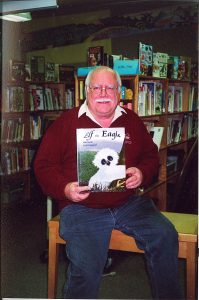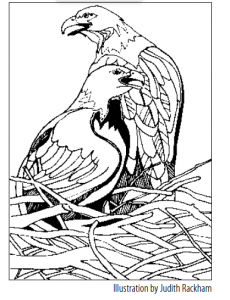This is the latest in a series of The Planning Department articles that suggest ways to organize school-wide literacy events around a single book title. The previous articles are available online at www.CanadianTeacherMagazine.com. Click on “Articles” and then on “Literacy.”

Author Ron Smith
As soon as Elf the Eagle broke through his shell and popped his head out into the wide, wide world, three surprises greeted him.
First, his egg tooth, the big bump on his beak, throbbed from all the chipping he’d done from inside the egg. He’d knocked himself silly with two days of rat-a-tat-tatting.
Second, his eyelids felt as heavy as a sea lion’s chins and everything he looked at was as fuzzy as a pussy willow.
Finally, his legs felt wobbly, as if he were trying to stand on a pool of jellyfish. He kept falling over.
He was quite discouraged. Quite. He just wanted to go to sleep.
And so he closed his eyes, but not before noticing that he shared the nest with another shadowy creature. Who was that? he wondered.
And so begins the story of Elf, an eaglet who worries about a myriad of things. He worries about the nest being built so high off the ground. What had his parent been thinking? He worries about his sister Edwina who keeps hopping up on the rim of the nest and flapping her wings. What a show off! He worries about his name. Was he really to grow up small and tricky? Finally, when Elf’s baby down has been replaced by strong brown feathers, his parents stop bringing him food. What was going on? Elf began to get very hungry. One day, as his mother passes by with a tempting morsel of fresh trout, Elf teeters off the edge of the nest. As he is hurtling towards the rocks below, his parents yell at him to flap his wings. He does. After several somersaults, he is able to flap both of his wings in unison and is airborne. He overcomes his fear of heights and learns to love the sensation of wheeling and soaring through the sky.
The next morning, Elf sat on a branch below the nest, below the family aerie, and watched dawn spread along the jagged rim of the mountains. He couldn’t wait. He felt his feathers twitch. As soon as he saw it, he would fly up into the sky and touch the sun.
This beautifully illustrated book by Ron Smith and Ruth Campbell is a joy to read aloud! As it addresses the learning outcomes for many areas of the curriculum and for multiple grade levels, our staff thought it would be a great choice for our next school-wide literacy event. This is how we proceeded. To follow our plan, you will need to find guest resource people with similar skills who are willing to visit your school.
WHAT RESOURCES WERE NEEDED?
Materials
- multiple copies of Elf the Eagle by Ron Smith (Oolichan Books, ISBN 0-88982-241-7)
- lesson plans and instructional materials developed by the staff
- eagle webcam: http.handcockwildlifechannel.org/
People
- grade group planning teams
- student cooking teams to prepare birds nest cookies for each class to celebrate the beginning of the theme
- Debbie Lambert, our music teacher, as the music/drama co-ordinator for our final assembly performance
- Solomon Seward, a carver, to demonstrate his silver carving skills
- Noel Brown a carver, to demonstrate his wood carving skills
- Ron Smith, the author, to read the book to each class. He also discussed the making of the book and answered many of the children’s questions.
WHAT WAS THE SEQUENCE OF EVENTS
October
- The choice of book was made. Our school literacy committee shortlisted a number of titles and the staff made the choice at a staff meeting.
January
- A staff brainstorming session was held to gather information and ideas for the following: field trips, cross-grade grouping activities, available resources (people, books, videos, music, etc.). We also talked about specific Before, During and After Reading activities.
February
- We celebrated the opening of the theme with a school assembly. Together we watched a short video clip of some work done by a local veterinarian and a dentist. After several attempts they had successfully constructed an artificial beak for a wounded bald eagle that had been found and taken to a nearby wildlife recovery centre. A leadership group from an intermediate class addressed the assembly. They had organized a fundraiser for the “adopt an eagle” program at the centre. For each dollar raised, a picture of an eagle was coloured and placed in a “nest” in the front hallway of the school. During the course of the theme our school raised enough money to provide care to five eagles for one year. At recess of this same day, each class received a plate of birds nest cookies to share.
- During this month each class read the story and engaged in the planned activities. Some classes developed Science or Social Studies units springboarding from the book (life cycles, food chains, aboriginal legends and stories, etc.).
- Solomon Seward visited our school for a day. Each class enjoyed a half hour visit with the artist and watched him demonstrate his carving skills. He carved in copper and silver.
- Noel Brown spent a day demonstrating wood carving. He left behind a wall mounted eagle carving that now hangs in the lobby of the school.
- Ron Smith, the author, was greeted enthusiastically by the children. Each grade group met with him for an hour in the library, where he read the story and showed the illustrations in a power point presentation. Most groups came prepared with a wide variety of questions, which he very generously spent time answering.
- Cross Grade Grouping: Our school regularly engages in cross-grade grouping activities. Each staff member leads a group of K-7 students in an event (art/craft/literacy/sport/game, etc.) For the Elf the Eagle theme we focussed on art and craft projects that decorated the hallway bulletin boards with paintings, 3-D masks, murals, collages, printmaking, etc.
- Webcam: We connected to the webcam on Hornby Island, British Columbia to watch the nesting process. For several weeks we projected the image onto a large screen in the library and students could watch the parents nurturing the eggs as the classes came and went during their library times.
March
- We celebrated the end of the Elf the Eagle theme at our monthly assembly. The story was highlighted with music, song and some very dramatic “flying” by student eagles. Ron Smith honoured us by attending this gala performance.
WHAT WORKED REALLY WELL?
Our school has engaged in two school-wide themes per year, for the past several years. Each one has been unique and successful in its own way. The strong connections that the students made to Elf, however, generated a degree of excitement and enthusiasm that really exceeded all of our other themes. Perhaps it was our close proximity to eagles (they circled our school almost daily during the nesting season) that fueled the interest? Perhaps it was our connection to the author? Maybe it was the universal theme of overcoming fear that resonated with the students. Whatever it was, this book worked on so many levels that I would encourage you to give it a try.
A LITERACY ACTIVITY THAT WORKS WITH THIS BOOK
BEFORE READING
Directed “Draw and Label” Activity
Materials
- one large piece of white paper for each student
- pencils and red pencil crayons
Goals
- To access the students’ prior knowledge about bald eagles
Process
- Direct the students’ drawing by modelling on the chalkboard.
- Have them draw a picture of an eaglet sitting in a nest, with an adult eagle sitting or flying nearby. Emphasize: big (fills the middle portion of the page) and bold (lots of details).
- After students have drawn for 10 – 15 minutes, have them stand and walk around the classroom to look at the other pictures.
- Have them return to their seats. Invite two or three students to comment on examples of drawings that they noticed had filled the “ big and bold” criteria.
- Allow the students a few more minutes to complete their drawings.
- Ask the students to share their drawings with one student who is sitting close to them. Ask them to identify the details in their pictures.
- Direct the students to label the details in their pictures by modelling on the chalkboard (e.g., talons, eyes, feathers, etc.) with red pencil crayons. If possible, they should add information to the labels (e.g., sharp talons for catching prey).
Reflection
- Invite the students to ask questions about bald eagles.
- Record the questions on chart paper.
 AFTER READING
AFTER READING
Directed “Draw and Label” Activity
At the end of the theme (after having read Elf and a variety of other sources of information about bald eagles) have the students repeat the draw and label activity.
Materials
- the drawings from the BEFORE READING activity
- blue pencil crayons
Goal
- To determine the new information that the students have learned about bald eagles.
- To see if all of their questions have been answered.
Process
- Ask the students to share their original labelled picture with someone sitting nearby. Have the students talk about any new information that they have gathered during the study.
- Ask the students to take a blue pencil crayon and add all of their new information to the page. They can work on the back side of the paper if necessary.
Reflection
- Invite the students to notice how much new information they have gathered during the reading of the book or completion of the bald eagle theme.
- Read through the questions generated at the beginning of the theme and check to see if they have all been answered.
ABOUT THE AUTHOR
Brenda Boreham
Brenda is the Literacy Resource Teacher at her school. This part-time position allows her to plan fun literacy events when she isn’t busy in her own classroom.
This article is from Canadian Teacher Magazine’s September 2009 issue.











